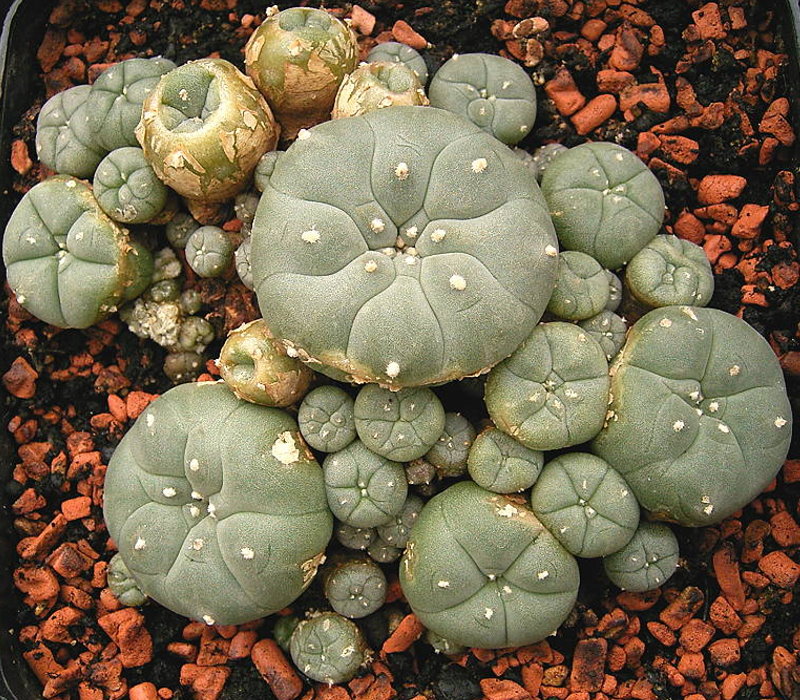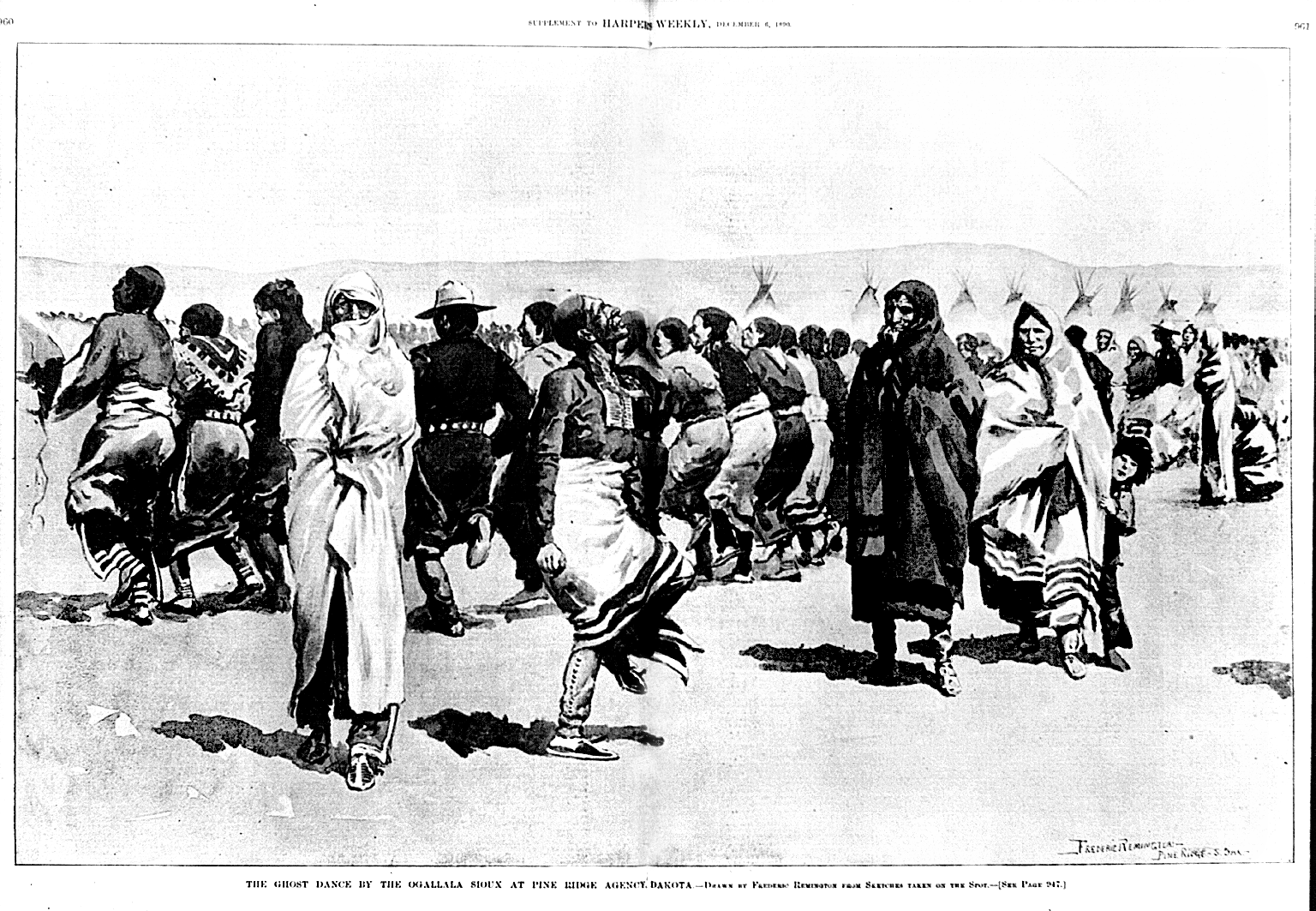|
John Wilson (Caddo)
"John Wilson the Revealer of Peyote" (c.1845–1901) was a Caddo medicine man who introduced the Peyote plant into a religion, became a major leader in the Ghost Dance, and introduced a new peyote ceremony with teachings of Christ. John Wilson's Caddo name was Nishkû'ntu, meaning "Moon Head." Though he was of half-Lenape descent, quarter-blood French, and quarter-blood Caddo, John Wilson spoke only the Caddo language and identified only as a Caddo. He is believed to have been born in 1845, when his band of Caddo were still living in Texas. They were driven into Indian Territory in 1859. Wilson, being interested in religion and only known as a medicine man, sought out a path to be a peyote roadman in 1880.Stewart 86 As the Ghost Dance ceremonies regained popularity in Oklahoma, he became one of its most active leaders in the Indian Territory. During a two-week period, Wilson consumed peyote for spiritual reasons and said he was shown essential astronomical symbols represent ... [...More Info...] [...Related Items...] OR: [Wikipedia] [Google] [Baidu] |
Caddo
The Caddo people comprise the Caddo Nation of Oklahoma, a federally recognized tribe headquartered in Binger, Oklahoma. They speak the Caddo language. The Caddo Confederacy was a network of Indigenous peoples of the Southeastern Woodlands, who historically inhabited much of what is now East Texas, west Louisiana, southwestern Arkansas, and southeastern Oklahoma. Prior to European contact, they were the Caddoan Mississippian culture, who constructed huge earthwork mounds at several sites in this territory, flourishing about 800 to 1400 CE. In the early 19th century, Caddo people were forced to a reservation in Texas. In 1859, they were removed to Indian Territory. Government and civic institutions The Caddo Nation of Oklahoma was previously known as the Caddo Tribe of Oklahoma. The tribal constitution provides for election of an eight-person council, with a chairperson. Some 6,000 people are enrolled in the nation, with 3,044 living within the state of Oklahoma. [...More Info...] [...Related Items...] OR: [Wikipedia] [Google] [Baidu] |
Peyote
The peyote (; ''Lophophora williamsii'' ) is a small, spineless cactus which contains psychoactive alkaloids, particularly mescaline. ''Peyote'' is a Spanish word derived from the Nahuatl (), meaning "caterpillar cocoon", from a root , "to glisten". p. 246. See peyotl in Wiktionary. Peyote is native to Mexico and southwestern Texas. It is found primarily in the Sierra Madre Occidental, the Chihuahuan Desert and in the states of Nayarit, Coahuila, Nuevo León, Tamaulipas, and San Luis Potosí among scrub. It flowers from March to May, and sometimes as late as September. The flowers are pink, with thigmotactic anthers (like ''Opuntia''). Known for its psychoactive properties when ingested, peyote has at least 5,500 years of entheogenic and traditional medicine, medicinal use by Indigenous people of the Americas, indigenous North Americans. Description The various species of the genus ''Lophophora'' grow low to the ground and they often form groups with numerous, crowded sho ... [...More Info...] [...Related Items...] OR: [Wikipedia] [Google] [Baidu] |
Ghost Dance
The Ghost Dance ( Caddo: Nanissáanah, also called the Ghost Dance of 1890) was a ceremony incorporated into numerous Native American belief systems. According to the teachings of the Northern Paiute spiritual leader Wovoka (renamed Jack Wilson), proper practice of the dance would reunite the living with spirits of the dead, bring the spirits to fight on their behalf, end American westward expansion, and bring peace, prosperity, and unity to Native American peoples throughout the region. The basis for the Ghost Dance is the circle dance, a traditional Native American dance. The Ghost Dance was first practiced by the Nevada Northern Paiute in 1889. The practice swept throughout much of the Western United States, quickly reaching areas of California and Oklahoma. As the Ghost Dance spread from its original source, different tribes synthesized selective aspects of the ritual with their own beliefs. The Ghost Dance was associated with Wovoka's prophecy of an end to colonial expan ... [...More Info...] [...Related Items...] OR: [Wikipedia] [Google] [Baidu] |
French American
French Americans or Franco-Americans (french: Franco-Américains), are citizens or nationals of the United States who identify themselves with having full or partial French or French-Canadian heritage, ethnicity and/or ancestral ties. They include French-Canadian Americans, whose experience and identity differ from the broader community. The state with the largest proportion of people identifying as having French ancestry is Maine, while the state with the largest number of people with French ancestry is California. Many U.S. cities have large French American populations. The city with the largest concentration of people of French extraction is Madawaska, Maine, while the largest French-speaking population by percentage of speakers in the U.S. is found in St. Martin Parish, Louisiana. Country-wide, as of 2020, there are about 9.4 million U.S. residents who declare French ancestry or French Canadian descent, and about 1.32 million per the 2010 census, spoke French ... [...More Info...] [...Related Items...] OR: [Wikipedia] [Google] [Baidu] |
Caddo Language
Caddo is a Native American language, the traditional language of the Caddo Nation. It is critically endangered, with no exclusively Caddo-speaking community and only 25 speakers as of 1997 who acquired the language as children outside school instruction. Caddo has several mutually intelligible dialects. The most commonly used dialects are Hasinai and Hainai; others include Kadohadacho, Natchitoches and Yatasi. Linguistic connections Caddo is linguistically related to the members of the Northern Caddoan language family; these include the Pawnee-Kitsai (Keechi) languages (Arikara, Kitsai, and Pawnee) and the Wichita language. Kitsai and Wichita are now extinct, and Pawnee and Arikara each have fewer surviving speakers than Caddo does.Native Languages of the Americas, 2011 Another language, Adai, is postulated to have been a Caddoan language while it was extant, but because of scarce resources and the language's extinct status, this connection is not conclusive, and Adai is gene ... [...More Info...] [...Related Items...] OR: [Wikipedia] [Google] [Baidu] |
Texas
Texas (, ; Spanish language, Spanish: ''Texas'', ''Tejas'') is a state in the South Central United States, South Central region of the United States. At 268,596 square miles (695,662 km2), and with more than 29.1 million residents in 2020, it is the second-largest U.S. state by both List of U.S. states and territories by area, area (after Alaska) and List of U.S. states and territories by population, population (after California). Texas shares borders with the states of Louisiana to the east, Arkansas to the northeast, Oklahoma to the north, New Mexico to the west, and the Mexico, Mexican States of Mexico, states of Chihuahua (state), Chihuahua, Coahuila, Nuevo León, and Tamaulipas to the south and southwest; and has a coastline with the Gulf of Mexico to the southeast. Houston is the List of cities in Texas by population, most populous city in Texas and the List of United States cities by population, fourth-largest in the U.S., while San Antonio is the second most pop ... [...More Info...] [...Related Items...] OR: [Wikipedia] [Google] [Baidu] |
Indian Territory
The Indian Territory and the Indian Territories are terms that generally described an evolving land area set aside by the Federal government of the United States, United States Government for the relocation of Native Americans in the United States, Native Americans who held aboriginal title to their land as a sovereign independent state. In general, the tribes ceded land they occupied in exchange for Land grant#United States, land grants in 1803. The concept of an Indian Territory was an outcome of the US federal government's 18th- and 19th-century policy of Indian removal. After the Indian Territory in the American Civil War, American Civil War (1861–1865), the policy of the US government was one of Cultural assimilation of Native Americans#Americanization and assimilation (1857–1920), assimilation. The term ''Indian Reserve (1763), Indian Reserve'' describes lands the Kingdom of Great Britain, British set aside for Indigenous tribes between the Appalachian Mountains and t ... [...More Info...] [...Related Items...] OR: [Wikipedia] [Google] [Baidu] |
Medicine Man
A medicine man or medicine woman is a traditional healer and spiritual leader who serves a community of Indigenous people of the Americas. Individual cultures have their own names, in their respective languages, for spiritual healers and ceremonial leaders in their particular cultures. Cultural context In the ceremonial context of Indigenous North American communities, "medicine" usually refers to ''spiritual'' healing. Medicine men/women should not be confused with those who employ Native American ethnobotany, a practice that is very common in a large number of Native American and First Nations households.Alcoze, Dr Thomas M. Ethnobotany from a Native American Perspective: Restoring Our Relationship with the Earth" in ''Botanic Gardens Conservation International'' Volume 1 Number 19 - December 1999Northeastern Area State and Private Forestry,Traditional Ecological Knowledge: Sustaining Our Lives and the Natural World at ''United States Department of Agriculture, Forest Ser ... [...More Info...] [...Related Items...] OR: [Wikipedia] [Google] [Baidu] |
Peyote Roadman
The Native American Church (NAC), also known as Peyotism and Peyote Religion, is a Native American religion that teaches a combination of traditional Native American beliefs and Christianity, with sacramental use of the entheogen peyote. The religion originated in the Oklahoma Territory (1890–1907) in the late nineteenth century, after peyote was introduced to the southern Great Plains from Mexico. Today it is the most widespread indigenous religion among Native Americans in the United States (except Alaska Natives and Native Hawaiians), Canada (specifically First Nations people in Saskatchewan and Alberta), and Mexico, with an estimated 250,000 adherents as of the late twentieth century. History Historically, many denominations of mainstream Christianity made attempts to convert Native Americans to Christianity in the Western Hemisphere. These efforts were partially successful, for many Native American tribes reflect Christian creed, including the Native American Church. ... [...More Info...] [...Related Items...] OR: [Wikipedia] [Google] [Baidu] |
Native American Church
The Native American Church (NAC), also known as Peyotism and Peyote Religion, is a Native American religion that teaches a combination of traditional Native American beliefs and Christianity, with sacramental use of the entheogen peyote. The religion originated in the Oklahoma Territory (1890–1907) in the late nineteenth century, after peyote was introduced to the southern Great Plains from Mexico. Today it is the most widespread indigenous religion among Native Americans in the United States (except Alaska Natives and Native Hawaiians), Canada (specifically First Nations in Canada, First Nations people in First Nations in Saskatchewan, Saskatchewan and First Nations in Alberta, Alberta), and Mexico, with an estimated 250,000 adherents as of the late twentieth century. History Historically, many denominations of mainstream Christianity made attempts to convert Native Americans to Christianity in the Western Hemisphere. These efforts were partially successful, for many Nat ... [...More Info...] [...Related Items...] OR: [Wikipedia] [Google] [Baidu] |
People From Caddo County, Oklahoma
A person ( : people) is a being that has certain capacities or attributes such as reason, morality, consciousness or self-consciousness, and being a part of a culturally established form of social relations such as kinship, ownership of property, or legal responsibility. The defining features of personhood and, consequently, what makes a person count as a person, differ widely among cultures and contexts. In addition to the question of personhood, of what makes a being count as a person to begin with, there are further questions about personal identity and self: both about what makes any particular person that particular person instead of another, and about what makes a person at one time the same person as they were or will be at another time despite any intervening changes. The plural form "people" is often used to refer to an entire nation or ethnic group (as in "a people"), and this was the original meaning of the word; it subsequently acquired its use as a plural form of per ... [...More Info...] [...Related Items...] OR: [Wikipedia] [Google] [Baidu] |









_1938.jpg)